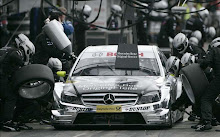

Looking back on the 1995 Global Endurance GT Series, in which MCLaren's legendary F1 GTR won 10 of the year's 12 races at its first attempt, it's worth remembering that the 'World's fastest production car' was never supposed to turn a competitive wheel. That the car won motorsport's most important and celebrated race - the Le Mans 24 Hours - tn the same year, make its impact on whata hugely competitive racing discipline seem all the more staggering.
Unsurprisingly, the man who can lay claim to much of the credit for persuadingthe TAG McLaren Group MD Ron Dennis to build a race car, Ray Bellm, contributed significantly to that success in 1995 - its first year of competition. Bellm hadtasted success in the mid-eighties in Group C sportscar and called upon his considerable experience to take McLaren to the top of GT racing, ahead of rivals Ferrari and Porsche.
Bellm led the Gulf Oil-sponsored GTC team and, with former British Formula 3 champion Mauricio Sandro Sala sharing the driving duties, took commanding victories infour of the first five races.
McLaren's strength in depth came from two additional cars run by experiencedsportcar team boss David Price, one of which belonged to German financier and sportcardriver Thomas Bscher - and another figure instrumental in persuading McLarento develop the F1 GTR. With former Le Mans winner Andy Wallace and John Nielsen bolsteringthe driver lineup, the cars - one carrying West sponsorship, the other adorned with colours of famous London department store Harrods - scored three victories apiece.
It was almost a clean-sweep for the Woking cars - the only hiccups in an otherwisefairlytale racing debut were a poor turn-out at Montlhery in France that gavevictory to Porsche 911, and a rare slip-up that allowed Ferrari's F40 to takethe spoils in Sweden. Nielsen and Bscher took the championship honours in the West-sopnsored F1 GTR.
The icing on the cake for McLaren - if indeed it needed any - was its extraordinatyvictory at the Le Mans 24 Hours. The mid-nineties at the Le Mans was boomtime forprototypes; few people expected a GT (production-based) car to stand a chance ofoutright victory. But the menacing-looking black F1 GTR, driven by JJ.Lehto, YannickDalmas and Masanori Sekiya, pounded round and round, unfazed by the incessant rainthroughout the weekend, to take a famous debut victory.
With more superlatives attacched to its name than any other road-going supercarever created, the McLaren F1 rewrote the automotive rulebook and, almost as if forfun, added its name to the motorsport history books, too.
Unsurprisingly, the man who can lay claim to much of the credit for persuadingthe TAG McLaren Group MD Ron Dennis to build a race car, Ray Bellm, contributed significantly to that success in 1995 - its first year of competition. Bellm hadtasted success in the mid-eighties in Group C sportscar and called upon his considerable experience to take McLaren to the top of GT racing, ahead of rivals Ferrari and Porsche.
Bellm led the Gulf Oil-sponsored GTC team and, with former British Formula 3 champion Mauricio Sandro Sala sharing the driving duties, took commanding victories infour of the first five races.
McLaren's strength in depth came from two additional cars run by experiencedsportcar team boss David Price, one of which belonged to German financier and sportcardriver Thomas Bscher - and another figure instrumental in persuading McLarento develop the F1 GTR. With former Le Mans winner Andy Wallace and John Nielsen bolsteringthe driver lineup, the cars - one carrying West sponsorship, the other adorned with colours of famous London department store Harrods - scored three victories apiece.
It was almost a clean-sweep for the Woking cars - the only hiccups in an otherwisefairlytale racing debut were a poor turn-out at Montlhery in France that gavevictory to Porsche 911, and a rare slip-up that allowed Ferrari's F40 to takethe spoils in Sweden. Nielsen and Bscher took the championship honours in the West-sopnsored F1 GTR.
The icing on the cake for McLaren - if indeed it needed any - was its extraordinatyvictory at the Le Mans 24 Hours. The mid-nineties at the Le Mans was boomtime forprototypes; few people expected a GT (production-based) car to stand a chance ofoutright victory. But the menacing-looking black F1 GTR, driven by JJ.Lehto, YannickDalmas and Masanori Sekiya, pounded round and round, unfazed by the incessant rainthroughout the weekend, to take a famous debut victory.
With more superlatives attacched to its name than any other road-going supercarever created, the McLaren F1 rewrote the automotive rulebook and, almost as if forfun, added its name to the motorsport history books, too.
















No comments:
Post a Comment